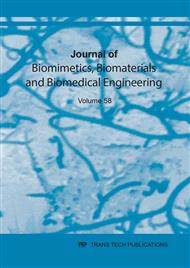[1]
Y. Boykov, J. Marie-Pierre, Interactive Graph Cuts for Optimal Boundary & Region Segmentation of Objects in N-D Images. International Conference on Computer Vision, Vancouer, (2001).
DOI: 10.1109/iccv.2001.937505
Google Scholar
[2]
Y. Boykov , V. Kolmogorov, An experimental comparison of min-cut/max flow algorithms for energy minimization in vision, IEEE Transactions on Pattern Analysis and Machine Intelligence, 26, 9 (2004) 1124-1137.
DOI: 10.1109/tpami.2004.60
Google Scholar
[3]
R. Carsten, B. Andrew, GrabCut: Interactive Foreground Extraction Using Iterated Graph Cuts, in ACM Transactions on Graphics, (2004).
DOI: 10.1145/1015706.1015720
Google Scholar
[4]
K. Oyebode, J. Tapamo, Adaptive parameter selection for graph cut-based segmentation on cell images, Image Analysis and Stereology,1,30 (2016) 29-37.
DOI: 10.5566/ias.1333
Google Scholar
[5]
M. Beheshti, F. Jolon, G. Amin, Bio-Cell Image Segmentation using Bayes Graph- Cut Model, in The International Conference on Digital Image Computing: Techniques and Applications (DICTA), (2015).
DOI: 10.1109/dicta.2015.7371241
Google Scholar
[6]
W. Cai, L. Lei, M. Yang, A Gaussian Mixture Model-based clustering algorithm for image segmentation using dependable spatial constraints, in 3rd International Congress on Image and Signal Processing, Yantai, (2010).
DOI: 10.1109/cisp.2010.5647653
Google Scholar
[7]
Y. Al-Kofahi, W. Lassoued, W. Lee., B. Roysam, Improved automatic detection and segmentation of cell nuclei in histopathology images, IEEE Transactions on Biomedical Engineering,57, 4 (2010) 841 - 852.
DOI: 10.1109/tbme.2009.2035102
Google Scholar
[8]
G. Narjes, V Alireza, T Ardeshir, N. Pardis, Segmentation of White Blood Cells From Microscopic Images Using a Novel Combination of K-Means Clustering and Modified Watershed Algorithm, Journal of Medical Signals and Sensors, 7, 2 (2017) 92–101.
DOI: 10.4103/2228-7477.205503
Google Scholar
[9]
K. Oyebode, J.R. Tapamo, Automatic segmentation of cell images by improved graph cut-based approach, Journal of Biomimetics, Biomaterials and Biomedical Engineering, 29, (2016) 4-80.
DOI: 10.4028/www.scientific.net/jbbbe.29.74
Google Scholar
[10]
K. Oyebode, Improved Thresholding Method for Cell Image Segmentation Based on Global Homogeneity Information, Journal of Telecommunication, Electronic and Computer Engineering, 10,1 (2018) 13-16.
Google Scholar
[11]
M. Merone, P. Soda, On Using Active Contour to Segment HEp-2 Cells, in IEEE 29th International Symposium on Computer-Based Medical Systems (CBMS), (2016).
DOI: 10.1109/cbms.2016.49
Google Scholar
[12]
T. Chan, L. Vese, An Active Contour Model without Edges, in Scale-Space Theories in Computer Vision, Greece, (1999).
DOI: 10.1007/3-540-48236-9_13
Google Scholar
[13]
Z. Xin, W. Yong, W. Guoyou, L. Jianguo, Fast and robust segmentation of white blood cell images by self-supervised learning, Micron,107, (2018) 55-7.
DOI: 10.1016/j.micron.2018.01.010
Google Scholar
[14]
R. Olaf, F. Philipp, B. Thomas, U-Net: Convolutional Networks for Biomedical Image Segmentation, Medical Image Computing and Computer-Assisted Intervention (MICCAI), Springer, LNCS, 9351,(2015) 234-24.
DOI: 10.1007/978-3-319-24574-4_28
Google Scholar
[15]
Y. Al-Kofahi, Z. Alla, G. Robert, M. Will, R. Mirabela, A deep learning-based algorithm for 2-D cell segmentation in microscopy images, BMC Bioinformatics, 19, 365 (2018).
DOI: 10.1186/s12859-018-2375-z
Google Scholar
[16]
Z. Zeng, W. Xie, Y. Zhang, Y. Lu, RIC-Unet: An Improved Neural Network Based on Unet for Nuclei Segmentation in Histology Images, IEEE Access, 7, (2019) 21420-21428.
DOI: 10.1109/access.2019.2896920
Google Scholar
[17]
J. Leng, Y. Liu, T. Zhang, P. Quan, Z. Cui,Context-Aware U-Net for Biomedical Image Segmentation, in 2018 IEEE International Conference on Bioinformatics and Biomedicine (BIBM), Madrid, Spain, (2018).
DOI: 10.1109/bibm.2018.8621512
Google Scholar
[18]
L. Shengrong, Y. Changchun, S. Hui, Z Hao, Seismic fault detection using an encoder–decoder convolutional neural network with a small training set, Journal of Geophysics and Engineering, 16, 1, (2019) 175-189.
DOI: 10.1093/jge/gxy015
Google Scholar
[19]
I. V. Saetchnikov, E. A. Tcherniavskaia and V. V. Skakun, Object Detection for Unmanned Aerial Vehicle Camera via Convolutional Neural Networks, IEEE Journal on Miniaturization for Air and Space Systems,2, 2, (2021) 98-103.
DOI: 10.1109/jmass.2020.3040976
Google Scholar
[20]
K. L. de Jong and A. Sergeevna Bosman, Unsupervised Change Detection in Satellite Images Using Convolutional Neural Networks,, 2019 International Joint Conference on Neural Networks (IJCNN) Budapest, Hungary (2019).
DOI: 10.1109/ijcnn.2019.8851762
Google Scholar


